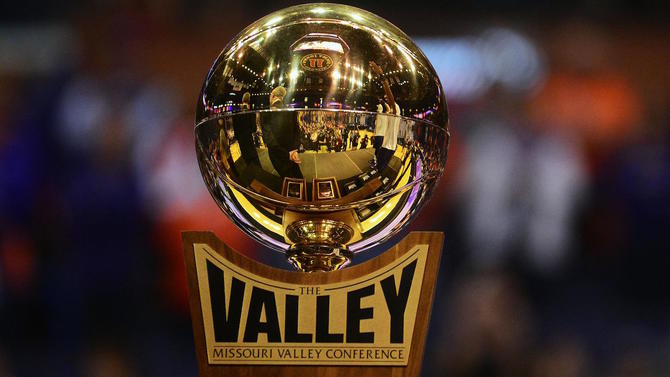It’s a bad day for the Missouri Valley Conference. There’s no getting around that reality. With Wichita State’s unanimous invitation from the American Athletic Conference, the MVC has now lost its two most prominent, successful members in the past four years. The flagships have left the bay. Creighton’s 2013 exodus to the Big East didn’t make geographical sense, but in consideration of every other basketball factor, it’s been the right move.
Wichita State is following Creighton’s path and hoping to have more respect, nationally, by upgrading its league. The Shockers are jettisoning out of a union that averaged an 11th-overall conference ranking at KenPom.com over the past four years. The American, in that same time span, had an average league ranking of 7.5. I cannot and do not fault Wichita State for doing this.
It does make me ache a bit for the Valley, though. And I can’t help but wonder if the NCAA Tournament section committee had given Wichita State a 6 seed instead of an 11 last year, a 5 seed instead of a 10 this year, perhaps it never gets to this point. I don’t blame the committee (no one is forcing Wichita State to do this), though it’s obvious that the committee is partly at fault. The institution’s decision is obviously rooted with basketball in mind, because it’s the only real reason to trek away from a proud and unique conference.
The American is a solid league, but it’s basically the opposite of the Valley: every single game requires a plane trip, the intra-league scheduling is not friendly, and the AAC is the last automatic bid decided (whereas the MVC is one of the first, and has a round-robin schedule).
Though the move is done with all sports in mind, basketball for Wichita State is acting like football does for most other schools that switch league allegiances. The school is (probably?) making the right move. But keep this mind: From a basketball perspective, Wichita State now goes from being the by-far best program in a one/two-bid conference to — big picture — being a top-five program in a fledgling league that’s still trying to establish its identity.
And there will be no awkwardness. The Shockers are bolting. After residing in the Valley since 1945, the team will be done with the MVC on June 30. Come July 1, Wichita State will be a member in the American across all sports.
So now the Missouri Valley, a conference that, with Wichita State, floated in the odd space between one- and two-bid status; it’s the only league in college basketball wherein this is/was true. The Valley sent three teams to the NCAAs in 2005, four in 2006, and two in 2007, 2012, 2013, 2015 and 2016. Now it appears to be cemented as a one-bid outfit.
So the MVC must turn forward. Who should the Valley go and get? There are some options out there, none of which can fully fill in the void left by Wichita State, but the candidates that Missouri Valley commissioner Doug Elgin, and his associates, should consider are very good. To me, there are only four schools that should be on the table. These are the four, and these are in order.
Saint Louis
State: Missouri
Division I since: 1915
Record: 1391-1194 (.538)
Conference history: Atlantic 10, Conference USA, Great Midwest, Midwestern Collegiate, Midwestern City, Metro, Missouri Valley
Regular-season conference titles: Seven
NCAA Tournament appearances: Nine
This has to be the first call. And the powers-that-be at Saint Louis should strongly consider a relocation. Many in college basketball see SLU as a top-four Atlantic 10 job because of the facilities, resources and location. It has great potential, but it’s had great potential forever, yet has only gone to nine NCAA Tournaments. On the surface, SLU would obviously lean toward staying in the A-10. Why leave a multi-bid league to go to a two-bid-at-best conference? But SLU is a former Valley member and would immediately become top dog in the conference if it made the switch. Its chances at getting into the NCAAs over the next decade would undeniably go up if it made the daring move. This would be an uncommon call, though. Rare is the school that opts to downgrade in conference.
SLU has also been a league nomad. Check out how many times it’s switched conferences. Last but certainly not least: the school is in St. Louis, the headquarters for the Missouri Valley. This would be a great fit and the best possible win for the MVC. Would take a leap for faith for SLU powers-that-be, though. SLU has just seven regular-season conference titles dating back to 1915. I could see the program getting to seven Missouri Valley regular-season titles in the next 15 years.
Valparaiso
State: Indiana
Division I since: 1978
Record: 634-552 (.535)
Conference history: Horizon and Summit League/Mid-Continent
Regular-season conference titles: 14
NCAA Tournament appearances: Nine
Valpo’s only been D-I since the late 1970s, but it’s got 1,100 wins, total, to its name over the ages. Its location, basketball-first mindset and solid history over the past 20 years make it an enticing replacement. If SLU really is a pipe dream, Valpo should be a reasonable get. And it’s a candidate that would make the Valley look fairly stable, if it were able to poach the Crusaders out of the Horizon. For Valparaiso, it’s a slight upgrade in league and a scene that allows the school to clearly remain top-three in its new digs. It’s going to be able to recruit at the same level still, if not a little higher. It has a workable basketball budget and name recognition to bring appeal to the league. Plus: the fanbase is good, too. From a culture-fit perspective, Valpo is a no-brainer.

Murray State
State: Kentucky
Division I since: 1953
Record: 1143-679 (.627)
Conference history: Ohio Valley
Regular-season conference titles: 26
NCAA Tournament appearances: 15
You can’t get a program with more winning tradition into the Valley than Murray State. The best combination of winning percentage, league championships, NCAA tourney showings and long-standing fan support. They love their Racers in Murray. The program’s also produced NBA players in recent years. Murray State, similar to Valparaiso, would fit the profile in terms of culture and brand for the Valley. In fact, Murray State just had a 29-year run of consecutive winning seasons end this past season. Solid basketball budget, a very good history of coaches (Mick Cronin, Mark Gottfried, Cal Luther, Steve Prohm, Billy Kennedy), good fan environment. The holdup: Murray State is a founding member of the Ohio Valley. Now, it’s not like other schools who were founding members of bigger conferences haven’t left for greener pastures (Syracuse, UConn, Maryland), but those decisions were made with football in mind. Murray State is a basketball school. Then again, because it’s a basketball school, if it has the opportunity to go to a premier mid-major basketball conference, shouldn’t it do so?
Belmont
State: Tennessee
Division I since: 1999
Record: 364-205 (.640)
Conference history: Ohio Valley, Atlantic Sun
Regular-season conference titles: 10
NCAA Tournament appearances: Seven
The best option in terms of academics. Belmont would be a a big-time get for the Valley in that regard. You can’t discount that factor. It’s also the second-best option in terms of school location. Belmont is located in Nashville, a growing metro with a lot of culture and a good location for the Valley to consider expanding its footprint. Budget-wise, Belmont falls far below the other three candidates (to put it one way: Belmont and Saint Louis operate in very different tax brackets, if you will). But it’s got a great coach in Rick Byrd, and in less than two decades worth of D-I membership it’s made only two fewer NCAA Tournaments than SLU has in a century’s worth. Belmont has won in the OVC and A-Sun, and it would win in the Valley. The MVC couldn’t miss on having any of these four, really but in terms of what works best and what would be the easiest transition, I think Belmont takes fourth — though I have little doubt it would flourish. You could argue its future looks as bright as any other MVC candidate.
If SLU is off the table immediately, I have to believe the next three in line would all consider leaving because they are in lesser leagues. You get any of the four programs listed above, you come out of the Wichita State situation looking pretty good. If, for whatever reason, you stay basketball-minded and are looking elsewhere, here are other possible candidates: Detroit (former member, big city spot), Oakland (stable program capable of making the move), UMKC (good location, would beg to get into the Valley), Fort Wayne (any school in Indiana fits MVC profile), SIU-Edwardsville (already a member in other sports, and is near the hub of the league, in St. Louis).
There is another option, though I don’t think it’s necessarily in the best interest for MVC basketball: Bringing in MVC football residents. That means all four North and South Dakota programs. That means going from a 10- to a 14-team league. North Dakota State and South Dakota State have been good in the past half-decade. But by doing this, you change the dynamic and the identity of the Valley. You also muck up small-league realignment, as a move such as that would incapacitate the Summit League, which has three of the four Dakota schools.
The reality is this: We think of the Valley in distinct terms, but the conference (which is the second-oldest union in college basketball to the Big Ten) has gone through myriad changes over the decades. It first started with Kansas, Missouri, Iowa State, Iowa and Nebraska. The only original member still in the league: Drake. Schools like Missouri State, Northern Iowa and Evansville haven’t even been in the league for 30 years. The Valley will be just fine, but there is no denying that it takes a huge hit with the loss of the Shockers. So if it wants to maintain its status as a top-12 league, it needs to lure in either Saint Louis, Valparaiso, Murray State and/or Belmont.





















